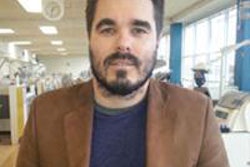
Up to 75% of head and neck trauma associated with domestic violence includes an oral injury. This means dentists could be the first healthcare providers able to identify and report evidence of domestic assault, according to a recent article.
A number of injuries in the oral cavity may offer clues to traumatic brain injury associated with domestic violence, according to researchers from the University of Arizona College of Medicine in Phoenix and other institutions. The article was published in the Journal of Aggression, Maltreatment and Trauma (April 11, 2019).
 Lead author Timothy Ellis Jr.
Lead author Timothy Ellis Jr."The overall purpose of the paper is to bring dentistry and its subspecialties into the conversation about traumatic brain injury, specifically in cases of domestic violence," stated lead author Timothy Ellis Jr., a dental student at the Midwestern University College of Dental Medicine in Phoenix, in a University of Arizona Health Sciences press release. The corresponding author of the article is Jonathan Lifshitz, PhD, director of the Translational Neurotrauma Research Program at the University of Arizona College of Medicine.
Dentition as a biomarker
More than 12 million people experience some type of domestic violence each year, according to a 2009 report from the U.S. Department of Justice. The authors cited figures of more than 41 million people experiencing domestic violence during their lifetime and almost 21 million of these victims sustaining a traumatic brain injury. Epidemiological studies show that a majority of domestic violence cases have a history of trauma to the head or neck, resulting in both traumatic brain injury and oral maxillofacial damage, they noted.
The authors proposed that if a correlation can be made between specific oral injuries and traumatic brain injury, then a patient's dentition could serve as a reliable biomarker for domestic violence-related traumatic brain injury. New or healed fractures in the mandible, zygomatic-orbital complex, dentoalveolar region, and nasal bone as potential signs of violence may indicate brain injury, according to previous research.
The authors also cited tooth fractures, luxations, maxillary fractures, and mandibular fractures as potential indicators of abuse and brain injury depending on patient history. Even tooth discoloration, blunted roots, and pulpal necrosis may warrant further inquiry and investigation, they wrote.
However, dentists receive little to no education about identifying and discussing domestic violence with potential victims, the authors noted.
"I have spoken with several dentists regarding the topic," Ellis stated in the release. "Many find it interesting; however, they have little experience. The most common answer I receive is that they had just never thought about it or believed that such a case would be more likely to present in a medical facility and, thus, it does not cross their mind when interacting with patients on a daily basis."
Only the beginning
“The message for dentists, hygienists, and other dental support staff is: Say something if they see something.”
The authors emphasize that this proposal is entirely conjecture, as minimal evidence exists linking the topics. Distinctive oral injuries that are sustained simultaneously with brain trauma as a result of domestic violence have yet to be fully described, they noted. Specific dental biomarkers of injury may improve identification, diagnosis, and prognosis of traumatic brain injury regardless of what the patient may or may not say.
The authors realized that, while research is necessary, making the dental team aware of traumatic brain injury/domestic violence based on oral biomarkers was important, Ellis told DrBicuspid.com.
"The paper is conjecture because no systematic research on the topic of dentists identifying [traumatic brain injury/domestic violence] based on oral biomarkers has been completed," he noted. "Our approach was to disseminate the topic, rather than trying to conduct years of research while community opportunities could be missed."
The next steps include continued efforts to raise awareness, build an educational curriculum based on interprofessional expertise, and then begin systemic data collection to validate the opportunity for dentists to intervene, according to Ellis.
The potential exists for dentists and their teams to make a meaningful connection with patients and communities by guiding potential victims to additional support and care, he pointed out.
"The message for dentists, hygienists, and other dental support staff is: Say something if they see something," he stated.



















